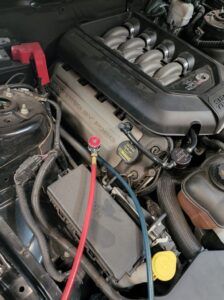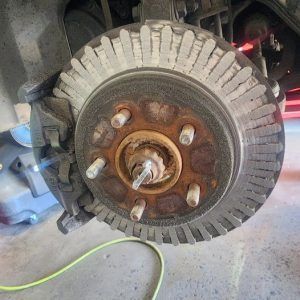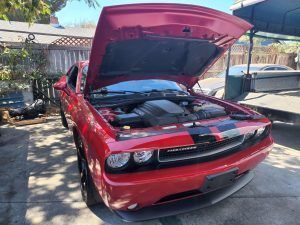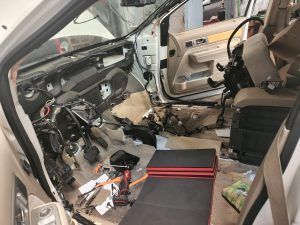Professional Radiator Repair: What To Expect When You Take Your Car To The Shop
When you bring your car to a professional radiator repair shop, you can expect a thorough and efficient process that will get your vehicle back on the road in no time.
The technicians will begin by conducting an initial assessment of the radiator problem, using their expertise to identify the underlying issue. They will then diagnose and explain the repair process to you, ensuring that you understand what needs to be done and why.
Once the problem has been identified, the faulty components will be replaced with high-quality parts to ensure optimal performance and longevity. Testing and quality assurance procedures will be carried out to guarantee that the repair has been successful.
Finally, your vehicle will be returned to you, fully repaired and ready to hit the road once again. With the help of skilled professionals, your radiator repair experience will be seamless and hassle-free.
Key Takeaways
– Professional radiator repair shops offer thorough and efficient repair processes.
– Initial assessment includes a thorough inspection of the radiator, checking for visible signs of damage or leaks, examining for cracks, corrosion, and loose connections, checking coolant level and quality, and troubleshooting to pinpoint the exact cause of the problem.
– Diagnostic tests such as pressure tests and temperature measurements are conducted to diagnose the problem accurately.
– The repair process includes detailed inspection of the radiator and other components, diagnostic tests like pressure tests and coolant flushes, replacement of faulty components with new ones, final inspection for proper installation and functioning, testing procedures for pressure, heat, and flow, and addressing any deviations to meet required standards.
Initial Assessment of the Radiator Problem
When you bring your car to the shop, the mechanic will take a look at your radiator to determine the issue. The initial assessment of the radiator problem involves a thorough radiator inspection to identify any visible signs of damage or leaks. The mechanic will carefully examine the radiator for any cracks, corroded areas, or loose connections. They’ll also check the coolant level and quality to ensure proper functioning.
During the radiator inspection, the mechanic will follow a troubleshooting process to pinpoint the exact cause of the problem. This may involve conducting pressure tests to check for any leaks, using specialized tools to measure the temperature and flow rate of the coolant, and inspecting other components of the cooling system such as the radiator cap, hoses, and thermostat.
The mechanic will document their findings and provide a detailed explanation of the diagnosis and repair process. They’ll explain the specific repairs needed to fix the radiator problem and address any related issues. This comprehensive explanation will help you understand the mechanics of your car’s cooling system and make informed decisions about the necessary repairs.
Transitioning into the subsequent section about the diagnosis and explanation of the repair process, the mechanic will then proceed to discuss the steps required to fix the radiator problem.
Diagnosis and Explanation of the Repair Process
Upon arrival at the shop, the technician will thoroughly examine your vehicle and provide a detailed explanation of the repair process. They’ll assess the condition of your radiator and identify any issues that may be causing it to malfunction. The technician will explain the repair options available to you based on the diagnosis.
Here’s what you can expect during the diagnosis and explanation of the repair process:
1. Detailed Inspection: The technician will inspect the radiator, hoses, and other components to identify any leaks, cracks, or clogs. They’ll use specialized tools and equipment to ensure a thorough examination.
2. Diagnostic Tests: To pinpoint the exact problem, the technician may perform various diagnostic tests such as a pressure test or a coolant flush. These tests help identify any underlying issues that may not be immediately visible.
3. Explanation and Recommendations: Once the diagnosis is complete, the technician will explain the findings in a clear and understandable manner. They’ll discuss the repair options available to fix the specific radiator problem and provide recommendations based on their expertise.
With a clear understanding of the repair process and the options available to you, you can make an informed decision on how to proceed.
In the subsequent section, we’ll discuss the replacement of faulty components to restore your radiator’s functionality.
Replacement of Faulty Components
To get your radiator back in working order, all you need to do is let the skilled technician replace any faulty components with new ones.
When you bring your car to the shop for radiator repair, the technician will start by conducting a thorough radiator inspection. This involves checking for any leaks, cracks, or damage to the radiator itself, as well as examining the surrounding components such as hoses and fans. Once any issues are identified, the technician will proceed with the replacement of faulty components.
During the replacement process, the technician will carefully remove the damaged parts and install new ones. This may include replacing a cracked radiator tank, a faulty thermostat, or a damaged radiator fan. It’s important to ensure that all new components are of high quality and compatible with your specific car model.
After the replacement is complete, the technician will perform a final inspection to ensure that all components are properly installed and functioning correctly. This is a critical step in the radiator maintenance process as it guarantees the longevity and efficiency of your radiator system.
With the faulty components replaced, your radiator will be ready for the next step: testing and quality assurance.
Testing and Quality Assurance
Once the faulty components have been replaced, it’s time to put your newly repaired radiator to the test and ensure its quality and performance. Professional radiator repair shops employ rigorous testing procedures and quality control measures to ensure that your radiator is functioning optimally before returning your vehicle to you.
During the testing phase, the radiator is subjected to various conditions to evaluate its performance. Here is what you can expect during this process:
– Pressure Testing: The repaired radiator is pressurized to check for any leaks or weak points. This ensures that the radiator can withstand the normal operating pressure of your vehicle’s cooling system.
– Heat Testing: The radiator is subjected to extreme temperatures to determine its ability to dissipate heat effectively. This test ensures that the repaired radiator can keep your engine cool under demanding conditions.
– Flow Testing: The flow of coolant through the radiator is measured to ensure that it is circulating properly. This helps identify any blockages or restrictions that may affect the radiator’s performance.
Throughout these testing procedures, the repair technicians closely monitor the radiator’s performance and compare it to manufacturer specifications. Any deviations are promptly addressed to ensure the radiator meets the required standards.
Once the testing and quality assurance process is complete, your vehicle is ready for the final repair and return.
Final Repair and Return of Your Vehicle
After the rigorous testing and quality assurance process, it’s time for the exciting part – getting your vehicle back in top shape and ready to hit the road again! At the professional radiator repair shop, we understand the importance of returning your car to you as quickly as possible. We strive to provide a seamless experience by adhering to a well-defined return timeline. Our skilled technicians work diligently to complete the repairs efficiently and effectively.
To ensure customer satisfaction, we follow a systematic approach to the final repair and return of your vehicle. Once the radiator repair is complete, our technicians conduct a thorough inspection to ensure all repairs have been successfully executed. This includes checking for any leaks, ensuring proper coolant flow, and verifying the radiator’s functionality.
To give you a clear picture of what to expect, here is a breakdown of our final repair and return process:
| Step | Action |
| —- | —— |
| 1 | Final inspection and testing of the repaired radiator |
| 2 | Reinstallation of the radiator into your vehicle |
| 3 | Verification of proper fit and alignment |
| 4 | Refilling the coolant system with the appropriate coolant |
| 5 | Conducting a final road test to guarantee optimal performance |
Once these steps are completed, your vehicle is ready to be returned to you. We take pride in our commitment to customer satisfaction and ensure that your car is returned to you in excellent condition, meeting all safety and performance standards.
Frequently Asked Questions
Are there any alternative options to repairing the radiator, such as replacing it altogether?
When considering radiator repair alternatives, one option is to replace the radiator altogether. This has the advantage of providing a brand new radiator, but it can be more expensive than simply repairing the existing one.
Regular radiator maintenance has many benefits, including prolonging the lifespan of your radiator and preventing costly repairs. Signs of a failing radiator include overheating, coolant leaks, and a strong odor of antifreeze.
Can I drive my car immediately after the radiator repair is completed, or is there a waiting period?
You can drive your car immediately after radiator repair is completed. However, there may be driving restrictions and post-repair maintenance to follow. Make sure to consult with the repair shop for specific instructions.
Conclusion
In conclusion, when you take your car to the shop for professional radiator repair, you can expect a thorough assessment of the problem followed by a detailed diagnosis and explanation of the repair process.
The faulty components will be replaced with high-quality replacements, and rigorous testing and quality assurance procedures will be conducted to ensure the effectiveness of the repair.
Finally, your vehicle will be returned to you in optimal condition, ready to hit the road with a properly functioning radiator.







